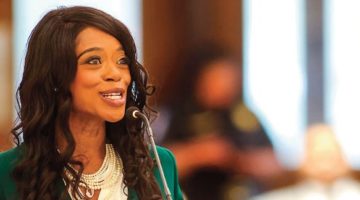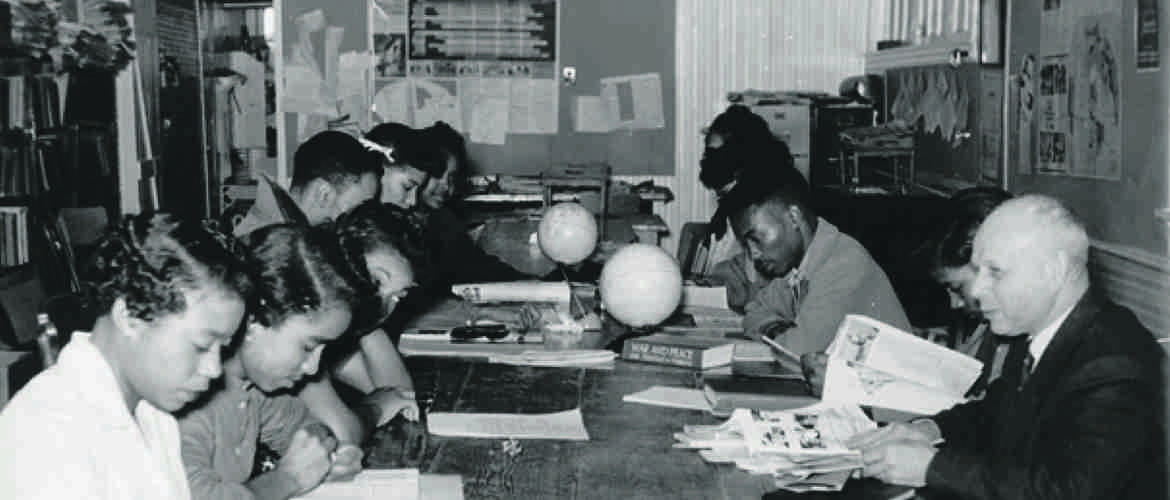CORAL GABLES — The visit to the Coral Gables Museum took Enid Pinkney back in time. That’s not unusual for Pinkney, chairman of the Hampton House Trust and a local legend in historic preservation and exhibits.
Pinkney came to the museum for the opening of Beyond Swastika and Jim Crow: Jewish Refugee Scholars at Black Colleges. The photos and artifacts transported her back to the late 1940s when she was a student at Talladega College in a very segregated Alabama.
“It’s exhilarating,” Pinkney said. “There was Swayne Hall, where I took classes … where I lived, went to the library.” Then she saw the name of one of her professors, Donald Rasmussen. He and his wife Lore, are among the Jewish academics celebrated in the exhibit, which opened Oct. 5 at Coral Gables Museum, 285 Aragon Ave.
The museum partnered with Florida International University’s Exile Studies Program, the Center for Humanities in an Urban Environment and the Department of English to bring a traveling version of the exhibit to South Florida, where it will stay until Jan. 11.
Beyond Swastika and Jim Crow was created by the Museum of Jewish Heritage – A Living Memorial to the Holocaust. The purpose of the exhibit is to showcase the work of Jewish professors who taught at HBCUs in the United States in the 1940s and beyond. Many of those institutions of higher learning were in the Southern U.S. — not the most welcoming place for blacks or Jews. Yet the academics found refuge and employment on those campuses.
The exhibit tells their narrative beginning just before World War II, said Michael Gillespie, director of the Center for the Humanities in an Urban Environment at FIU.
“They had a great deal of difficulty finding work except at HBCUs, which were very welcoming,” Gillespie said. “These academics had strong relationships with the students. Most of the schools were in the South. Academics were beginning to experience discrimination as they had in Germany.”
Gillespie saw the exhibit in May 2013 in Philadelphia, and was moved by the experience. “It talks about American history that very few people know about. I didn’t know about it,” he said.
“It touches on basic issues of social justice. It goes beyond the Jewish and African American experience.
“All of us have experienced a sense of alienation at one time or another. It reminds us of how painful that is. The obligation is not to continue that experience by isolating others.”
Christine Rupp, executive director of the Coral Gables Museum, said artifacts such as the Ku Klux Klan uniform are jarring. Also striking are receipts for $28 in fines paid by the Rasmussens, who were arrested for having lunch with a black civil rights colleague at a black café in Birmingham.
“You read that stuff and you wonder ‘why.’ It’s appalling, shocking. It insults my intelligence,” Rupp said. “What were people thinking?”
Ironically, Pinkney said she was unaware of their Jewish heritage.
“We never really talked about that fact. To me they were just white people,” she said. “They got into the consciousness of being in the South. Talladega was real southern. It was like an oasis to have the white teachers integrating with black teachers.”
One thing she did know is the Rasmussens were “very nice and very smart. They really demanded so much from you. Also, there was this social consciousness about them. They were very much aware of what the black situation was.”
Part of that meant helping students circumvent rules that relegated them to a segregated train car, Number 1, when they returned to their homes for holidays, she recalled. They complained to Donald Rasmussen, who hatched a plan.
“He said, ‘the next time you go home, bring us the money the parents spend for your ticket and we will purchase your ticket.’” The next trip home, Pinkney’s ticket was for a different car, Number 5, which carried white passengers. The attendant looked at her, then the ticket, and eventually called over two co-workers.
“The three discussed what to do with me and this ticket. So finally, they let me in car 5. But, they put me on the back seat, which was under the motor and didn’t recline. I got in the car but I got the worst seat,” she laughed.










No Comment